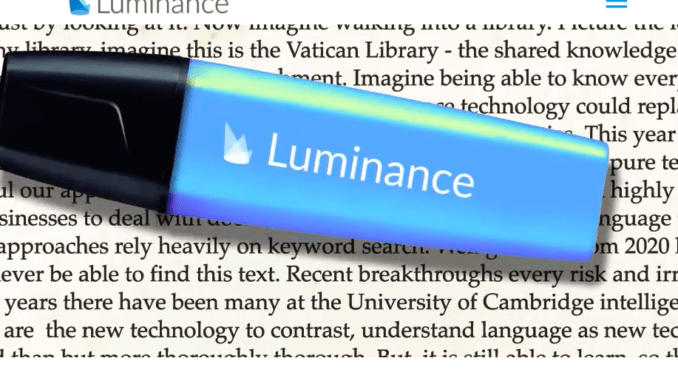
Legal AI company, Luminance, has been growing at an incredible speed over the last two and a bit years, and is now targeting inhouse legal teams. A case in point is bagging Think Money Group (TMG), its first British financial services company to adopt Luminance Corporate, the AI platform’s new offering for inhouse legal teams.
Unlike some other legal AI companies, Luminance has not waited around to perfect just one area of review, but instead has headed out in all directions. While it may have started with M&A due diligence, as most NLP/ML doc review systems tend to do, it soon moved into property, then litigation and investigations – cutting into the ediscovery world – and now also corporate legal functions.
In short, they are trying to cover as much ground as fast as they can. This perhaps is only possible because of the funding they have behind them, namely Invoke Capital, headed by former Autonomy founder, Mike Lynch, plus other major investors.
And it has worked, at least as far as can be seen, with 119 customers across 40 countries, including 13 of the Global 100 law firms and three of the ‘Big Four’ accountancy firms.
Artificial Lawyer caught up with Emily Foges, the dynamic CEO of Luminance, to put a few questions to her.
The first one, which is on the lips of many of Luminance’s competitors, is: ‘OK, so you have clients, but how much are they using it?’
Foges will not give exact figures, or even vague figures, on use levels. But she notes that ‘the legal market is moving through to the tipping point’, i.e. where it becomes totally normal to use an AI system for review work across a wide range of use cases. That means greater use of their tech.
When it comes to that use, Foges will only say that it’s hard to outline, as ‘some clients use Luminance for 100% of their M&A work, others less so’. She adds that in any given week not all law firms with Luminance contracts ‘are logging on’.
However, she stresses that ‘use levels per firm are going up’.
She also opens up a little with regard to the sales process. She explains that there can be a very long sales cycle and not everyone goes on to be a long term client after a pilot. This is something Artificial Lawyer (AL) can testify to, in one case a firm used it and felt it had not met expectations and is now likely to look for other systems when it’s ready to.
In another case the firm carried on after the pilot, and the tech met expectations, but they simply didn’t have the internal resources and staff time to devote to the system to make it worthwhile. So, the reality is they don’t really use it very much.
But, these ups and downs go with the territory, and Luminance must be doing a lot right to have grown so fast. Moreover, if you listen to some of their customers, many are very happy.
Let’s go back to the new corporate client for a moment.
Ryan Swann, General Counsel of TMG, said: ‘A few days into using Luminance Corporate, we could already see its benefits in action with the contract set we showed it. This is exactly what we had been looking for in a technological solution, we wanted something straightforward that wasn’t going to require an extensive training period but rather add value to our work straight away.’
There you go. Straight from the horse’s mouth. And, being realistic, there is no way any particular tool is going to receive 100% ‘likes’ – (see the forthcoming AL Product Review of Kira Systems.) This is perhaps even more the case with systems that involve some machine learning.
That said, Foges and team are keen to point out you can do a lot with Luminance without the need for extensive machine learning.
In TMG’s case they explain: ‘The system’s pattern-recognition algorithms detected subtle variations in the contracts without the need for TMG to train it or do a keyword search to find these anomalies.
‘Luminance Corporate’s clustering feature sorted the contracts, automatically grouping them by language, detail and template. TMG gained insight into the documents, quickly understanding what was in them and how their variations compared to the company’s model contract. The technology was also able to identify clauses within the contracts that risked being non-compliant with current and upcoming regulatory changes.’
Foges adds that they will work with inhouse legal teams to provide them with what they want. If they want to focus on GDPR issues, they can do that. If they want to focus on new rules about sanctions, they can do that too.
In short, as noted above, Luminance is seeking to move into every possible use case for its technology. And why not? If you have a tool that works, then why not seek to apply it everywhere it can add value?
All in all an impressive performance. Is Luminance’s growth without its challenges? Of course not. But overall, they have come a long way in a very short space of time. What happens next remains to be seen.